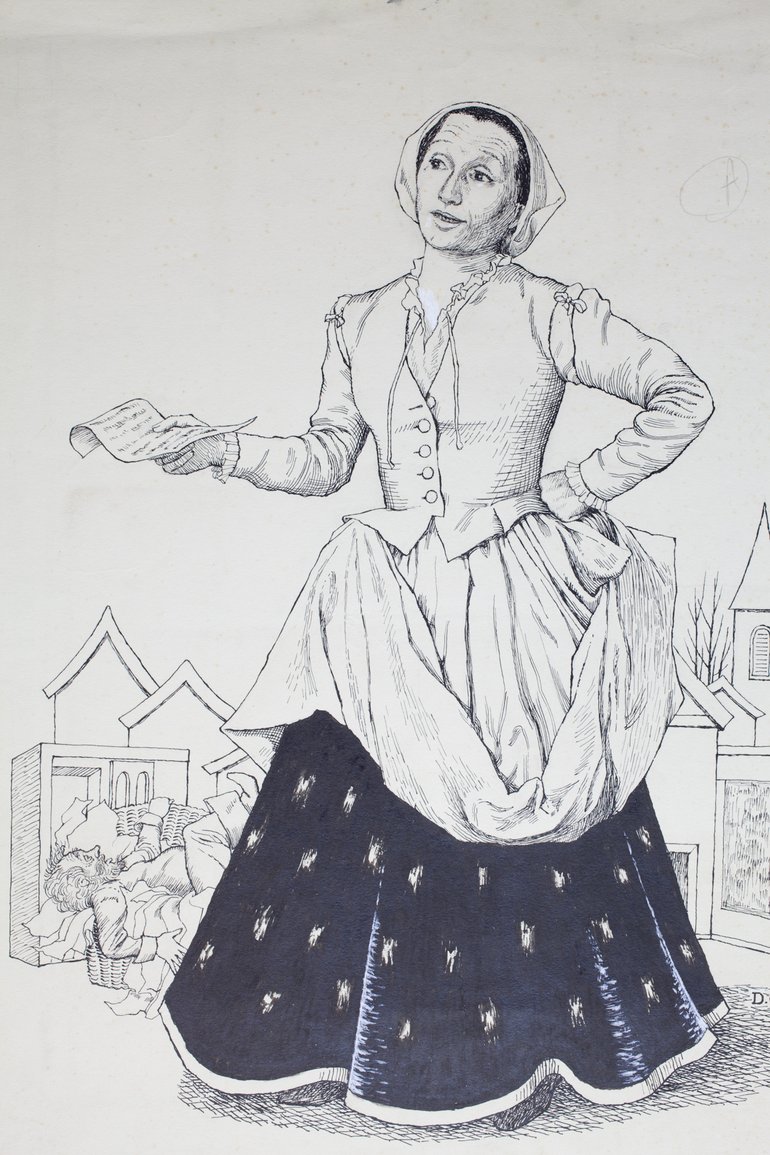My name is Mary Willet and I have been an intern here at the Shakespeare Birthplace Trust in the Collections Department since mid-July. Presently, I am gaining my Masters in Museum Studies at the University of Leicester. Shortly after arriving at the SBT, I began a cataloguing project that I was to work on for the duration of my internship. The project consisted of cataloguing sixty-two original drawings of actors in RSC performances from the 1950s and 1960s. These had been commissioned by the puppeteer Waldo Lanchester for reproduction and sale in his shop on Henley Street. The drawings had been in the collection for a while, but had not yet been catalogued, so I was given the task of identifying and recording the condition that they were in and putting the information into the digital catalogue, Qi.
This was an exciting, new experience for me to embark on!
This was an exciting, new experience for me to embark on! Although I had some foundational understanding and practice which I had gained from my Master’s program, there were many things I was learning to do for the first time. One of the first steps was simply measuring the drawings, although it did take me some time to figure out how to read millimetres on a measuring tape! But once I figured that out, it became second nature to do so. The next step was to assess the overall condition; were the drawings in a good, fair, poor or unacceptable condition? Fortunately none of the drawings were in an unacceptable condition and only one has been deemed to be in a poor condition. All of the other drawings are in fair condition, although some are closer to good.
I wrote down and described everything that I observed. Were there tears or rips in the pictures; if so, how long were they and where were they located? Were there stains or other marks? Were there pinholes in the corners; if so, how many? Was the paper buckling or creasing? These were just some of the questions and observations that I made as I examined each drawing. All my observations and measurements were written down in a notebook and were then entered into Qi. Nevertheless, I was not just simply examining the drawings and adding the information to the digital catalogue. Although this was mainly what I did, I was also re-housing the drawings. The folder that they were in at the time was not in great condition and needed to be replaced. As I finished examining the drawings, they were moved into a new document box and the tissue paper was replaced, providing a safe home for the drawings.

After gathering all the information and data from the drawings, I had to input all of it into the database. When I first arrived at the SBT I did not have any experience working with the Qi cataloguing system, I had only briefly worked with the eHive cataloguing system during my Masters. Now I can honestly say that I am much more confident as I navigate the catalogue, enter the data and connect the drawings to related records. I would not claim that I am a master at the system yet, but after inputting all the data I am becoming more proficient. Nevertheless, whenever I am in doubt or unclear about some aspect of Qi, I know that there are plenty of people in the office who would be happy to answer my questions and help me figure out what to do. At first it felt so overwhelming, but through repetition, assistance and going through other entries, I can confidently say that I do not feel that way anymore.

I spent many hours in the strong room examining the
drawings, measuring them and writing everything down. It was fascinating to see
how these five different artists can have such different styles when drawing
the RSC actors and the characters that they played. One artist chose to draw on
board for example, while the others simply drew on paper. Even when different
actors were playing the same character in subsequent years, they were
completely distinct and unique. No two drawings were completely alike! What also fascinated me were the different notations and measurements on the drawings
that would have been used to help turn the drawings into prints. You are able
to see what the artist and printer thought was the best way to reduce the larger drawings
into smaller prints.
I have three favourite drawings: Michael Redgrave as Benedick (SBT 2017-13/23) and Googie Withers as Beatrice (SBT 2017-13/24) in the 1958 performance of ‘Much Ado About Nothing’ (these two drawings can be laid side by side and create a small scene), and Joyce Redman as Mistress Ford, in the 1955 performance of ‘The Merry Wives of Windsor’ (SBT 2017-13/19) – in the background you can see Falstaff tumbling in a heap of laundry! These three drawings are by David G. Phillips. There are many incredible drawings by five different artists in this group and other people will no doubt have their own favourites.

I may only be an intern at the SBT for a little while, but every day brings a new experience and opportunity.
The incredible hands-on experience that this project has given me is something that I will be able to draw upon wherever I go. Working here has taught me so much, I may only be an intern at the SBT for a little while, but every day brings a new experience and opportunity. This is just one of several projects that I have worked on during my time at the SBT and each project has given me different hands-on experience and exciting new tasks to work on! I am so incredibly grateful for this experience and all the wonderful people that I have had the chance to meet and work with!
All the drawings are currently being photographed and are available to view on our online catalogue.
